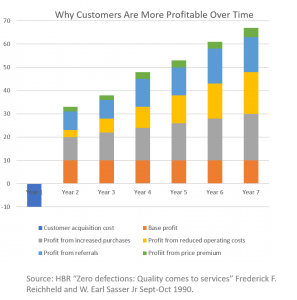The customer is your profit centre. Smart businesses know that the strongest source of growth and profit is the customer not the product. This is because a customer who is fully engaged with your business will provide you with extra sales, more use, more spend and longer tenure. In fact they may become advocates and recruit customers for you. Spend to build customer engagement is not a cost, it is an investment in future value. This is Customer Thinking.

#1 Find Out What Customers Value. What is the secret sauce that leads customers to become engaged with your business in this way? The secret is simple – you have to understand what it is that customers value. What they value is what they are paying for, and why they come back. It’s their choice to buy based on their assessment of what is valuable to them. So you can’t assume you know best on their behalf, you have to get close to customers and really understand their value assessment before you design and build your offer, and then stay in close touch to keep your offer relevant and competitive.
You may think it is easy to understand what customers value, maybe even so obvious that you don’t need to ask them. Or you may think that you get this feedback from your salesforce every week, or through sales data. Or you may have an excellent technology team who keep coming up with features that the customer is certain to need. Or you may be undertaking a digital transformation that will reduce cost and increase convenience – so what’s the problem?
#2 Get Close To Customers. All these approaches fail to check directly with the customer, not just about the individual elements of your offer, but holistically and in context. To unlock the cookie jar of sustainable long-term growth and profit you need to get close to your customers to understand, at a deeper level, what they really value. This is the difference between inside-out thinking – where the business is designing the customer offer to suit the business, and outside-in thinking where the offer is defined to add value in the eyes of the customer, which requires the continuing involvement of the customer in that definition.
#3 Add Functional and Emotional Benefits. What is valued by customers will no doubt include functional aspects of your product and service, such as speed, cost and accuracy. These may sound like the most important things to get right, and it is true that they are typically the table stakes. Business leaders like these elements because they are tangible to build and easy to measure. But for customers they are often just hygiene factors for a transactional purchase with no engagement or value-add. In fact if you don’t check carefully with the customer you may over-engineer and be wasting effort in improving performance aspects that are not noticed or important to the customer.
Some businesses build an efficiency centred proposition, streamlining and simplifying usage so it is easy to use and lower cost to provide. By establishing a dialogue with customers and improving understanding these businesses can confirm that convenience and price are valued, and are enough to be competitive. Often these factors alone are not enough and there needs to be additional focus for instance on the user experience on the website and in providing high quality service support.
#4 Collaborative Design For Value. To drive efficiency further you may look to re-engineer processes and a way of ensuring they improve and reflect the aspects valued most by customers is a process which we call co-creation. This is co-creation of value too – both the customer and your business come to an understanding that provides mutual value, after all you can’t afford to give the customer everything they might want unless they are prepared to pay for it.
An even greater level of customer value and long term financial return to the business may come from building a customer experience centred proposition. The smartest businesses know that the warmest, highest spending customers may value a range of more intangible elements in addition to the rational, tangible delivery components, and this is just as true for business customers as it is for consumers. So an example for a business customer might be to form a strategic partnership where the vendor works jointly with the customer to look ahead and create solutions that add value, by reducing waste and stock holding or developing novel solutions to previously unconsidered issues.
#5 Talk Directly To Customers. What is the process for Customer Thinking and unlocking growth and profit? The first step is to take a close look at what you know, what you think you know and what you don’t know. Most businesses find when they take this audit that many of the assumptions that they use to make decisions about customers are not actually based on evidence or data, and that there are contradictory views. We would suggest you look at all sources of information and talk to front line staff.
It will be important as a next step to talk directly to customers. There are many insight techniques for this, but the gold standard is a direct conversation facilitated with professional expertise. Building on this will be continuing dialogue, bringing the customer into a co-creation relationship where ideas are jointly developed that create mutual value. Taking this deep understanding and aligning it to the client business model to define an achievable and compelling growth strategy is the essence of Customer Thinking.
#6 Mindset Is A Barrier. What are the barriers? If it is so straightforward why do more businesses not employ Customer Thinking as a matter of course? The first issue is mindset, which needs to be championed from the top. Functional silos often pursue their own agendas, but Customer Thinking is a cross-functional opportunity to unite organisational goals behind a common theme – providing value to the customer.
In summary Customer Thinking provides a route to growth and profit through the understanding that customers who perceive deeper value in your offer will spend more, on more products, over a longer period than transactional product purchasers.
With this mindset it becomes vital to really understand what customers value rather than what we might assume they want, what is easy or low cost to provide or is the latest feature to emerge from the technology lab. Indeed we should be building solutions jointly with customer involvement, so that we really deliver what is valued.
The outcome is that smart businesses view the customer as the profit centre, not the product. Spend on building deeper customer relationships becomes an investment in future growth and profit, not a cost to be minimised.
BeyondCuriosity is a specialist insight agency for innovation, CX and growth.
If you would like to learn more, call or e-mail 07957 686366 chris.little@beyondcuriosity.com


